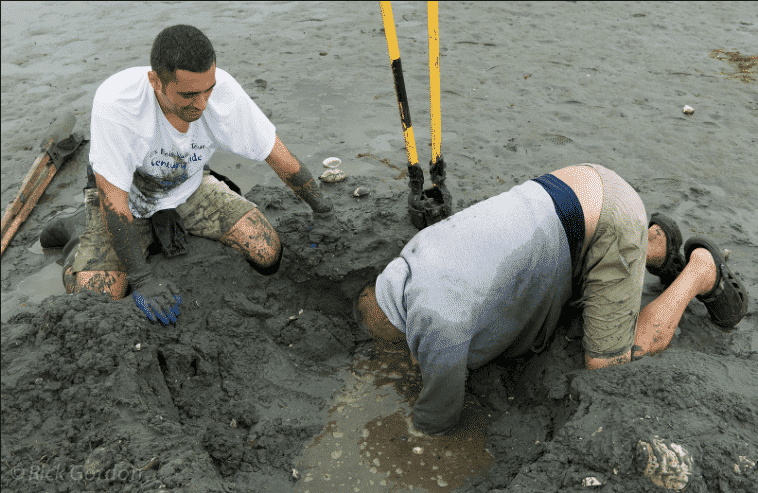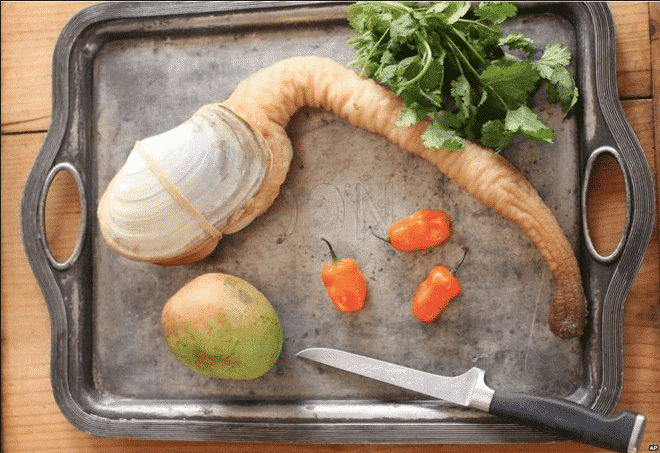Pronunciation: gooey- duck. Did you know these Pacific Northwest clams retail for more than $125 per pound in Asia? Adding purchases within the United States, Geoducks are an $80 million industry. That left us wondering a few things, mostly: how are more people not talking about these things?!
Fun Fact: Geoducks are the world’s largest burrowing clams.

How to Get a Geoduck:
As stated above, these big guys are the world’s largest burrowing clams. They also like to bury about two feet below the tide surface. But two feet isn’t going to stop anyone from getting these bad boys out, is it? No.
Since geoducks are only exposed during low tides, where you can then see or feel their siphons, it’s important to be able to track the tides of the beach you’re visiting. Local stores will have tide books. The siphons are about two inches long when they are opened, and are usually “creamy brown” in color, yum.

So you’ve found the siphon! Great, now you can start your dig! Not to fret if the siphon goes back under the sand, the geoduck itself can’t actually move so no need to rush. “If you’ve got a can or tube, center it on the siphon show, and force it down around the siphon as far as you can. Some diggers like to place a length of 2×4 across the top of the can, standing on it to force the can into the substrate. Then carefully dig out the sand and mud, without slicing the siphon. As the hole is excavated, it’s usually possible to force the can further down.”

At this point, you could quite literally be head and shoulders into the hole you’ve just dug, but be gentle and don’t pull on the siphon! Since it’s illegal to have only the siphon of the geoduck, even if it breaks, you have to keep digging to get the rest of it out with your hands. The first three geoduck you can to take with you, and that’s the limit! Why? Because adult geoducks cannot be “replanted.” And please, please, please, fill those holes back up!
Wait, replanted? Enter Geoduck Aquaculture!
This is where a person takes little geoduck clam “seeds” and plant them on tidelands and lets them grow for 5-7 years until they have reached full adult-size. In the Puget Sound alone, Geoduck farming makes up about 200 privately-owned acres.
This is currently a pilot project and is in the testing phases to see if it will be expanded to a Leasing Project where more sites will be added.

Can I really eat this thing?! Yes!
Okay, I’ve got myself a Geoduck, now what? Well lucky for you, we’ve found a really easy recipe that teaches you how to clean and prepare geoduck for your next recipe.

Step 1: Submerge the geoduck in boiling water for 30 seconds to blister and loosen the tough outer skin. Dunk in ice water to stop cooking. (Also known as blanching.)
Step 2: Slice along the shell on one side. Pry open the shell, and pull all the geoduck meat out. Discard shell. (You will want to watch the video included in the link at this point to get a good idea how to remove the innards of the geoduck.)
Step 3: Cut the breast of the geoduck away from the siphon. Reserve breast. Trim the end of the siphon until you have a clean edge. We do this just to make the siphon meat look better; it’s not necessary to do so. Cut the thick base meat away from the narrower tip of the siphon. Slice the tip open lengthwise and rinse out any sand or pebbles. Rinse the breast to remove sand.
Step 4: Fresh geoduck is often eaten raw. Keep cold until you’re ready to use. The breast is best for chopping up into small pieces, perhaps as a tartare. The narrower part of the siphon is best cut into lengthwise strips, perhaps for chowder. The siphon base can be sliced thin and served raw.
Note: We do not own these photographs.



4.5
I’m an avid geoduck clamer.I normally keep them alive for a day in cold fresh seawater with rubber band wraps. After a day their necks are elongated but swivel up when I handle or blanch them in hot water. Is there a way to keep their necks elongated prior to cleaning/cutting them ?
Yes. Scientists have proved beyond a doubt that fish, lobsters, crabs, and other sea dwellers feel pain. Lobsters’ bodies are covered with chemoreceptors so they are very sensitive to their environments. Boiling lobsters alive is particularly cruel